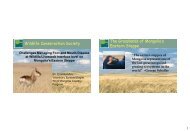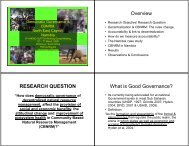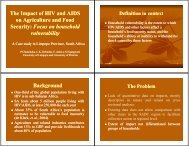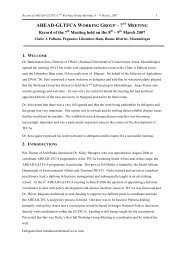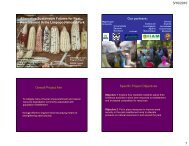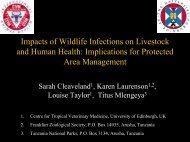Promotion of HIV/AIDS mitigation and wildlife conservation through ...
Promotion of HIV/AIDS mitigation and wildlife conservation through ...
Promotion of HIV/AIDS mitigation and wildlife conservation through ...
Create successful ePaper yourself
Turn your PDF publications into a flip-book with our unique Google optimized e-Paper software.
Mitigation <strong>of</strong> <strong>HIV</strong>/<strong>AIDS</strong> Impact<strong>and</strong> Wildlife Conservation <strong>through</strong>Improved Village PoultryProduction in Southern AfricaRobyn Alders <strong>and</strong> Filomena dos AnjosAcknowledgementsThanks to:• AHEAD - for getting me here!• ACIAR - Australian Centre forInternational Agricultural Research• AusAIDAID - Australian Agency forInternational Development• FAO - Food <strong>and</strong> AgricultureOrganization <strong>of</strong> the United Nations• WCS - Wildlife Conservation Society &Community Markets for Conservation• Farmers, extension workers,veterinarians, researchers <strong>and</strong> NGOsMalnutrition, Food Insecurity <strong>and</strong><strong>HIV</strong>/<strong>AIDS</strong>Why village poultry?In mixed farming systems in SouthernAfrica: very few households h own cattle (~10-20%) some own small ruminants (~30-40%),but most own village poultry (70-80%)United Nations World Food Programme. Interactive Hunger Map 2003
Newcastle Disease (ND) Major constraint where ND is endemic 50 – 80 % annual mortality Control requires both vaccination <strong>and</strong>biosecurity Thermotolerant, avirulent I-2 vaccinefacilitates ND control in rural areas beyondthe cold chain, administered by eye-dropevery 4 months I-2 ND vaccine master seed availablefree <strong>of</strong> charge from ACIARComponents <strong>of</strong> a sustainable NDcontrol program in rural areas Coordination <strong>of</strong> activitiesiti Appropriate vaccine & vaccine technology Efficient extension material &methodologies Simple M&E systems with both technical <strong>and</strong>socio-economic indicators Economic sustainability – commercialization<strong>of</strong> the vaccine (~USD 1.00/250 doses) &vaccination services (community vaccinatorcharges ~USD 0.02/bird), & marketing <strong>of</strong>surplus birds <strong>and</strong> eggsProject componentsApproximately 50% femalevaccinators Community development – governmentveterinary & extension services, communityleaders & groups, community vaccinators,NGOs Vaccine production, quality control <strong>and</strong>distribution – Animal Disease ResearchInstitute, Veterinary Services (VICs) & LocalCouncils Extension & training – facilitateunderst<strong>and</strong>ing d <strong>and</strong> communication ca o at all levelse
ND control extension materials Field manual – veterinarians &supervisors Training manual – trainers <strong>of</strong> communityvaccinators, 3-day training course Laboratory manual – vaccine production<strong>and</strong> quality control staff Extension worker & vaccinatormanuals Flip chart – extension workers, vaccinators& farmers Vaccination calendar Radio programs, posters, pamphlet &videoGeneral extension/communication materials“Healthy chickens, healthypeople” flip chart“Chicken reproduction” flipchartVillage chicken health <strong>and</strong>production field manual<strong>HIV</strong>/<strong>AIDS</strong> information Rural poultry eNewsletter –published every 6 monthsImpact monitoring & assessmentVillage chickens <strong>and</strong> <strong>HIV</strong>/<strong>AIDS</strong><strong>mitigation</strong> in Mozambique Baseline studies Participatory ruralappraisals Vaccination records- N o . birds vaccinated-N o . farmers participating-N o . active vaccinators- N o . vials distributed &sales Passive diseasesurveillanceSenhoraJoaquinaGuente(Gr<strong>and</strong>motherwith threegr<strong>and</strong>children)
Community-based ND control & village chickenrestocking <strong>of</strong> <strong>HIV</strong>/<strong>AIDS</strong> affected households ND control program at village level l implemented bycommunity vaccinators (who are also volunteercarers) with vaccination vouchers for vulnerableHHs Restocking <strong>of</strong> vulnerable HHs with one rooster <strong>and</strong>three hens purchased in the local area Poultry for restocking were held in quarantine forone week <strong>and</strong> vaccinated against ND prior todistribution Beneficiaries received training in ND control <strong>and</strong>low cost village poultry husb<strong>and</strong>ry Funded d by FAOImpact <strong>of</strong> pilot activities after12 monthsTotal # <strong>of</strong> participating HHs 98- # Female-headed HHs 63- # Gr<strong>and</strong>parent-headed HHs 29- # Child-headed HHs 6Total number chickens 364% HHs with chickens after 12months58Triple benefits <strong>of</strong> the villagechicken & <strong>HIV</strong>/<strong>AIDS</strong> project1. Direct support to the peopleaffected or infected by <strong>HIV</strong>/<strong>AIDS</strong>2. Income generation for the carers<strong>and</strong> the community-basedorganizations3. An increase in the carrying capacity<strong>of</strong> the communities in terms <strong>of</strong>supporting welfare activitiesVillage chickens <strong>and</strong> <strong>wildlife</strong><strong>conservation</strong> in ZambiaFarmers <strong>and</strong> their chickens …….
Village chickens <strong>and</strong> <strong>wildlife</strong><strong>conservation</strong> in Zambia… <strong>and</strong> the <strong>wildlife</strong>Improvement <strong>of</strong> village poultry production bycommunities surrounding South LuangwaNational Park Tsetse fly infested area → No cattle; very fewgoats; village chickens are very important ND outbreaks occur most frequently fromAugust to October Pilot project commenced in May 2007 in fiveChiefdoms funded by WCS <strong>and</strong> implementedin collaboration with COMACO ND vaccination campaigns implemented bycommunity vaccinators in July <strong>and</strong> November2007 using imported NDV4-HR vaccine COMACO promotes biodiversity <strong>conservation</strong>by promoting sustainable developmentResults to date in vaccinating areasPreliminary analysis# Chicke ns302520151050Vaccinating areas 2007: Av. # chickens per HH1 2 3 4 5ChiefdomsJulyNovemberThe July 2007 ND vaccination campaign wasimplemented in the face <strong>of</strong> an outbreak in onechiefdomBest to start new control activities well in advance <strong>of</strong>the period when ND outbreaks occur more frequentlyMore chiefdoms are requesting to join the ND controlprogramLow-cost village poultry husb<strong>and</strong>ry activities can nowbe promotedFurther study is required to determine if increasedchicken numbers will translate into decreased bushmeat sale <strong>and</strong> consumption
ConclusionsHealthy poultry, healthy peopleIncreased village chickenproduction also has thepotential to: Improve food security, assistin poverty alleviation, Assist with <strong>HIV</strong>/<strong>AIDS</strong><strong>mitigation</strong>, <strong>and</strong> Decrease bush meatconsumption in ruralpopulations.Thank you !Zikomo !Obrigada !Asante sana !



